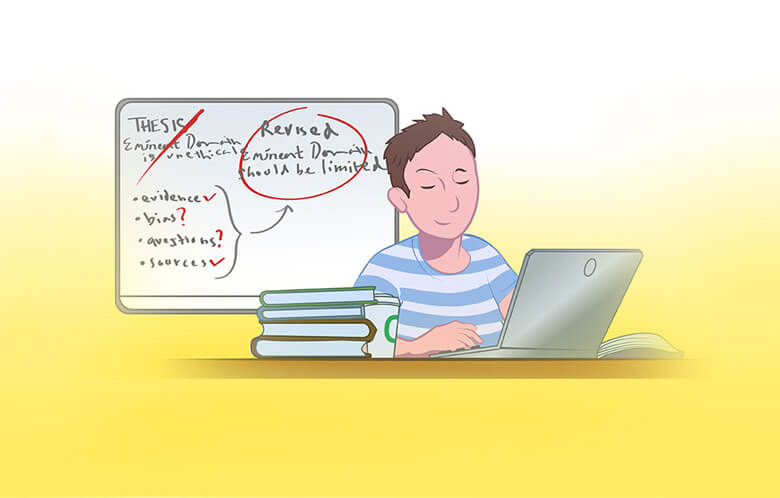A Lesson in Crafting Effective Arguments
One day, an 11th grade student came to me with a problem she was having with a literature paper. “I don’t know what to do,” she said. “I keep finding evidence that seems to go against my thesis. Can I just ignore it?” she added, hopefully.
She wasn’t the first student to struggle with a type of confirmation bias when it came to research and writing argument-driven papers. My students frequently seized on a thesis and rushed to find only information that proved it.
“Why don’t you just change your thesis?” I asked.
“I can do that?!” she blurted.
It was an “aha” moment for my student and for me; she’d been trying to build a “strong” argument by twisting facts to support it and censoring information that seemed incompatible. I’d been trying to teach students that “strong” arguments are guided by careful analysis of the evidence you find, but I hadn’t explicitly taught them that strong arguments are also flexible, measured and subject to change.
Further, I was curious about why this student didn’t feel ownership over her own paper, didn’t know she could change it, even if she wanted to. Was this, in part, because she was answering my question, my topic, my thought process, rather than investigating her own questions? I wondered: How often are kids rewarded for questioning their opinions and following those questions to see where they lead?
Asking Questions in a “Google Age”
In my work with the Right Question Institute, I connect with teachers around the country and beyond who are addressing these very questions in their classrooms, amplified now by the proliferation of “fake news,” the normalization of divisive public and political rhetoric, and the astonishing amount of information now a mere Google search away. In an age when we have all become arbiters of information and information gatekeepers, by way of the content we cultivate on our Facebook pages and Twitter feeds, it’s more urgent now than ever before that we develop responsible information literacy habits and critical consumption of media, facts and sources.
Teachers face a particularly acute challenge. A 2016 Stamford Graduate School of Education report found “a dismaying inability by students to reason about information they see on the internet.” Even savvy students, fluent in social media, have “a hard time distinguishing advertisements from news or identifying where information came from” or how reliable it is.
As usual, teachers have responded by curating and creating incredible resources to teach students to think more flexibly and creatively, to interpret textual evidence from several perspectives, and to develop nuanced, persuasive arguments that are open to civil, informed debate. The Question Formulation Technique (QFT) is one such strategy that taps into students’ natural curiosity as a starting point for critical analysis. Teachers from around the country have shared how they’ve used the QFT to get students asking questions about information, evidence, and assumptions to build greater empathy, engagement, and informed, effective arguments.
Student Questions for Class Debate and Discussion
In a Forensics class at Cuba-Rushford Central School District in Cuba, N.Y., Krista Tompkins used the QFT ahead of a class debate about capital punishment. In an initial poll, all but one student in the class was in favor of the death penalty. Students chose these sides “without a second thought, black and white,” Tompkins reported. “I wanted them to see the gray; I wanted them to struggle.”
As a Question Focus (a prompt), Tompkins showed students a clip of the death penalty carried out in the film The Green Mile. During the QFT, students came up with thoughtful questions, ranging from the practical (Is it efficient? Who pays for it? Who cleans up after?) to the moral (Why would people watch? Who would want to watch? Aren’t those people killing, too? Should the mentally ill be subject to the death penalty?) to the personal (If you were judge or jury, could you impose a sentence to end a life?).
After the QFT, the class was split 50/50 for or against the death penalty. “They really started thinking,” Tompkins said. Students weren’t so firmly “set” on one side or the other anymore.
Debating controversial issues in the classroom can be daunting for both teachers and students. While it can be an opportunity to strengthen student voice and build student capacity to participate productively in civil discourse, it’s also difficult to structure discussion in a way that is inclusive, intellectually rigorous, and supportive of dissent, mistakes and confusion. For Tompkins, the QFT “got them all involved,” even the students who were typically reluctant to participate in class discussions. Every student was able to ask questions and practice critical thinking, without the fear of looking “dumb.”
Student Questions and Information Literacy at the Library
Connie Williams, past president of the California School Library Association and National Board Certified Teacher Librarian in Petaluma, Calif., frequently uses the Question Formulation Technique in her work with students coming to the library for help with research.
When the school debate team came to Williams because they were concerned about countering the credibility of the sources their opponents presented during debates, she turned to the QFT.
“They wanted me to give them a list of authoritative places to go,” Williams noticed, “but there is no such thing.” Instead she worked with the students to drill down to what they were really asking and how they could solve the problem themselves. Rather than curating a list of authoritative sources, the team came away away with a list of questions they could ask themselves while reading and researching, as well as questions they could pose to other teams.
Instead she worked with the students to drill down to what they were really asking and how they could solve the problem themselves.
Instead she worked with the students to drill down to what they were really asking and how they could solve the problem themselves.
Recently, Williams led a group of students through the QFT using the Question Focus statement, “Everyone must become more information literate.” Williams was mid-way through an entire unit on sourcing and citation, when she realized, “we really need to dig deeper into why we’re doing all this citing, while we’re still in the middle of it.” And indeed, it seems clear that some students were still trying to understand why properly citing sources matters. They asked, for instance, “Does everyone need to be information literate? How does becoming information literate impact society as a whole? Why is information literacy a good thing?”
On the other hand, some students seem remarkably attuned to the risks of accepting information at face value. Who might benefit from people NOT being information literate? How might having a more literate population change the role of sources? How could information literacy change social media? Will websites disappear when people know how to tell if it is reliable or not? What will happen if we are not information literate?
That last question is perhaps particularly haunting to me because, as a teacher of literacy, it seems clear to me why being able to read and think critically is such a fundamental part of participating effectively in society. The beauty of the QFT is that the students get to ask, and answer, these questions for themselves.
Question Formulation as a Foundational Skill
Beyond the choices we make about which articles to share, what media we watch and which news sources we follow, our ability to communicate effectively with others relies on our ability to ask questions. The question may be the most overlooked, yet powerful tool we have for listening, challenging assumptions, crafting informed arguments, asserting oneself in unfamiliar or uncomfortable situations, for demanding answers and greater accountability.
Both educators in the field and researchers have noted significant gains in learning and teaching when students are empowered to ask questions in class. These students not only retain more content, but they also develop sophisticated critical thinking skills and engage more personally with the content and their own learning process. They also are better able to advocate for themselves and participate more effectively in decisions that affect them far beyond the classroom walls.
A strong argument, Williams says, is “an intellectual process, supported by your gut — because you asked the question.” It requires, she notes, a “willingness to be open, to take a hard look, and question.” More than ever before, all students need to develop the openness, intellectual rigor and curiosity that question-asking promotes.



